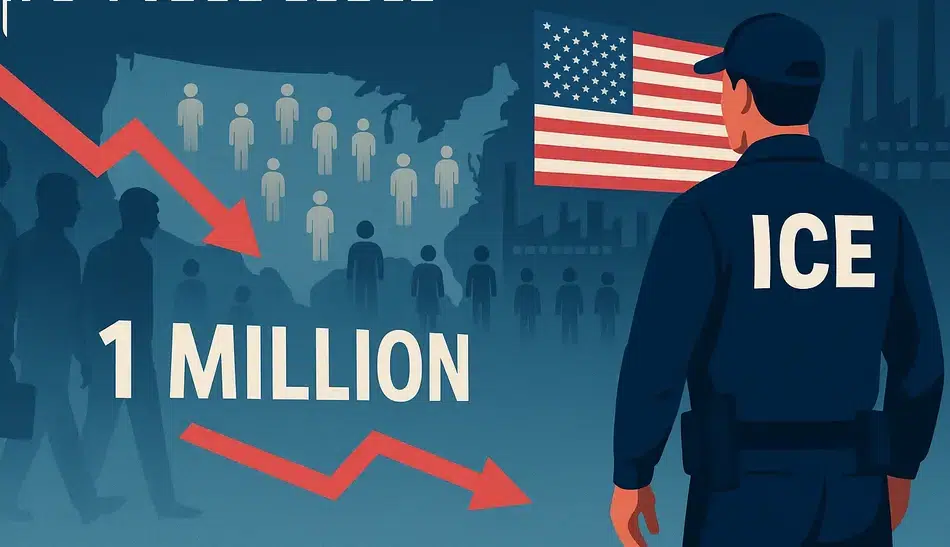As federal agencies ramp up worksite raids, tighten verification rules, and narrow visa pathways, economists warn the United States could lose more than one million workers from its active labor force over the next year. The potential shortfall arrives just as employers struggle to fill frontline and skilled positions alike, threatening growth in sectors from agriculture and hospitality to construction, logistics, health care, and tech support.
1. What Changed: From Guidance to Crackdown
For much of 2024, enforcement focused on penalizing exploitative employers while avoiding broad sweeps that could scare off lawful workers. In early 2025, that posture shifted. The Department of Homeland Security authorized Immigration and Customs Enforcement (ICE) to resume unannounced workplace operations in high-risk industries. Simultaneously, the Department of Labor expanded audits tied to H-2A, H-2B, and J-1 programs, and the Social Security Administration quietly reintroduced “no-match” letters that flag payroll discrepancies tied to invalid SSNs.
Together, these moves are pressuring companies to scrutinize every I-9 form, every subcontractor roster, and every seasonal hire—often leading to suspended workers, delayed onboarding, or terminated contracts when documentation can’t be produced fast enough.
2. The One-Million-Worker Hole: Where Losses Will Hit
2.1 Frontline, Low-Wage Sectors
- Agriculture & Food Processing: Seasonal crews that harvest, pack, and process food are heavily foreign-born. Even a 10–15% attrition could translate into tens of thousands of missing hands during peak harvest weeks, raising spoilage risks and food prices.
- Hospitality & Retail: Hotels, restaurants, and big-box retailers rely on immigrant labor for housekeeping, kitchen prep, stock replenishment, and last-mile logistics. A compliance-driven slowdown may leave shifts uncovered, forcing shortened hours or reduced service offerings.
2.2 Skilled Trades and Infrastructure
- Construction & Manufacturing: Federal infrastructure dollars are pouring into roads, bridges, water systems, and semiconductor fabs. Yet many skilled tradespeople—welders, electricians, CNC operators—are immigrants. Forced attrition will worsen already acute shortages, inflate project costs, and delay timelines.
2.3 Health Care and Home Care
- Nursing Aides & Home Health Workers: Aging demographics mean demand is soaring, but many aides are foreign-born. Facilities may face higher overtime costs, burnout, and waitlists.
2.4 Tech Support & Back-Office Roles
- IT Help Desks, Data Labeling, and BPO: Smaller firms increasingly tap immigrant and visa-dependent talent for essential but lower-margin tech tasks. Crackdowns disrupt continuity, forcing costly outsourcing or automation rushed under duress.
Need Tech Support or BPO Staff? Post Jobs Free on WhatJobs
Visa crackdowns and operational shakeups are leaving gaps in help desks, data labeling teams, and back-office support. Whether you’re stabilizing after a disruption or scaling with confidence, WhatJobs connects you with skilled tech and operations professionals—fast and free.
Post Your Tech Job Now →3. Employer Response: From Panic to Playbooks
Facing sudden enforcement risk, companies are rapidly building or expanding compliance infrastructures:
- Centralized I-9 Audits: Quarterly (or monthly) internal audits, digitized document storage, and dedicated compliance officers are becoming standard.
- Vendor & Subcontractor Vetting: Prime contractors now demand proof of work authorization from every staffing firm and temp agency—often with same-day turnaround requirements.
- Expedited Background & Status Checks: Employers are turning to third-party platforms that bundle criminal checks, E-Verify, and SSN verification into 24–48 hour packages to keep hiring pipelines moving.
- Cross-Training & Automation: To cushion sudden labor gaps, firms are cross-training employees across functions and accelerating automation projects (e.g., robotic palletizers, automated housekeeping equipment, AI scheduling tools).
4. Economic Ripples: Prices, Delays, and Productivity Puzzles
- Price Pressures: Scarcer labor in food, hospitality, and construction can push prices higher. Already-thin margins may prompt surcharges, service cuts, or reduced operating hours.
- Project Delays: Infrastructure and manufacturing build-outs risk slipping schedules as contractors scramble for authorized workers or wait on visa replacements.
- Productivity Trade-Offs: Automation can offset headcount losses, but rapid deployment without adequate training can create bottlenecks or safety issues.
5. Policy Options on the Table
Lawmakers and agencies are weighing fixes to avoid a self-inflicted labor squeeze:
- Targeted Visa Expansions: Proposals include raising H-2B caps for hospitality and construction, easing H-2A transfer rules between farms, and fast-tracking nurse and aide visas.
- Safe-Harbor Compliance Windows: Industry groups are asking DHS for “good-faith” grace periods, allowing employers to correct paperwork errors without immediate penalties.
- Modernized Verification Tools: Advocates push for a single, real-time federal verification portal that reduces duplicate checks and errors.
- Pathways to Status: Some legislators argue that limited legalization or work permits for long-term, law-abiding workers would stabilize key sectors while preserving enforcement against bad actors.
6. Human Impact: Fear, Mobility, and Community Strain
Beyond numbers, the crackdown fuels anxiety:
- Worker Flight: Fear of raids drives some employees to quit stable jobs, move across state lines, or go underground—making them more vulnerable to exploitation.
- Family Disruption: Detentions can separate breadwinners from dependents overnight, straining community support networks and local charities.
- Chilling Effect on Reporting: Workers may avoid reporting wage theft or safety violations if interaction with authorities could trigger status scrutiny.
Community organizations, unions, and legal clinics are scaling up “Know Your Rights” workshops, offering hotlines, and providing rapid-response legal aid to mitigate these harms.
7. What Businesses Can Do Now
Short-Term Tactics
- Conduct proactive internal audits and fix paperwork before audits arrive.
- Establish clear protocols for responding to ICE visits—who speaks, what is provided, and how to protect employee rights.
- Build contingency staffing plans: temp pools, cross-trained teams, and automation pilots ready to deploy.
Long-Term Strategies
- Invest in retention: higher wages, predictable schedules, and benefits that reduce turnover.
- Partner with community colleges and workforce boards to train domestic workers for entry-level and mid-skill roles.
- Advocate collectively: join industry coalitions pressing for balanced enforcement and sensible visa reforms.
8. Outlook: A Narrow Path Between Enforcement and Economic Reality
If current policies continue without offsets, the U.S. could face a painful squeeze: fewer workers, slower projects, and higher costs. Conversely, a calibrated approach—robust enforcement of bad actors coupled with pragmatic labor pathways—could protect both rule of law and economic momentum. The next six to twelve months will reveal whether Washington can thread that needle.
Frequently Asked Questions (FAQ)
Where does the “over 1 million workers” estimate come from?
Analyses aggregate potential attrition across sectors heavily dependent on immigrant labor—agriculture, hospitality, construction, caregiving, and logistics—based on enforcement patterns and past attrition rates during similar crackdowns.
Will automation fully replace these workers?
Not immediately. Automation can ease pressure in warehouses or repetitive tasks, but many roles—caregiving, hospitality service, field work—remain labor-intensive or require human judgment and interaction.
How can small businesses cope?
Small firms should adopt low-cost compliance tools, collaborate with local chambers for legal guidance, cross-train staff, and explore shared-services models for HR and verification.
Could stricter enforcement lower wages for native workers?
In theory, reduced labor supply could push wages up. But if businesses cut hours, automate, or close locations, total income in affected communities could still fall. Outcomes vary by sector and local demand.




